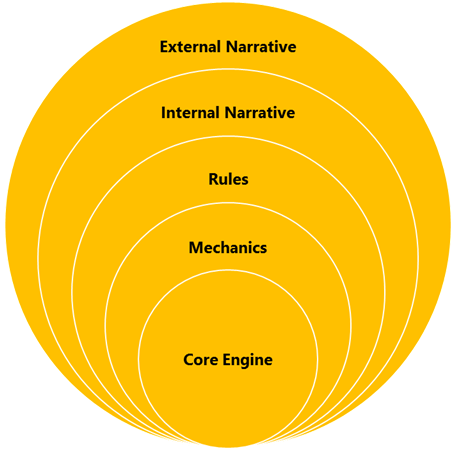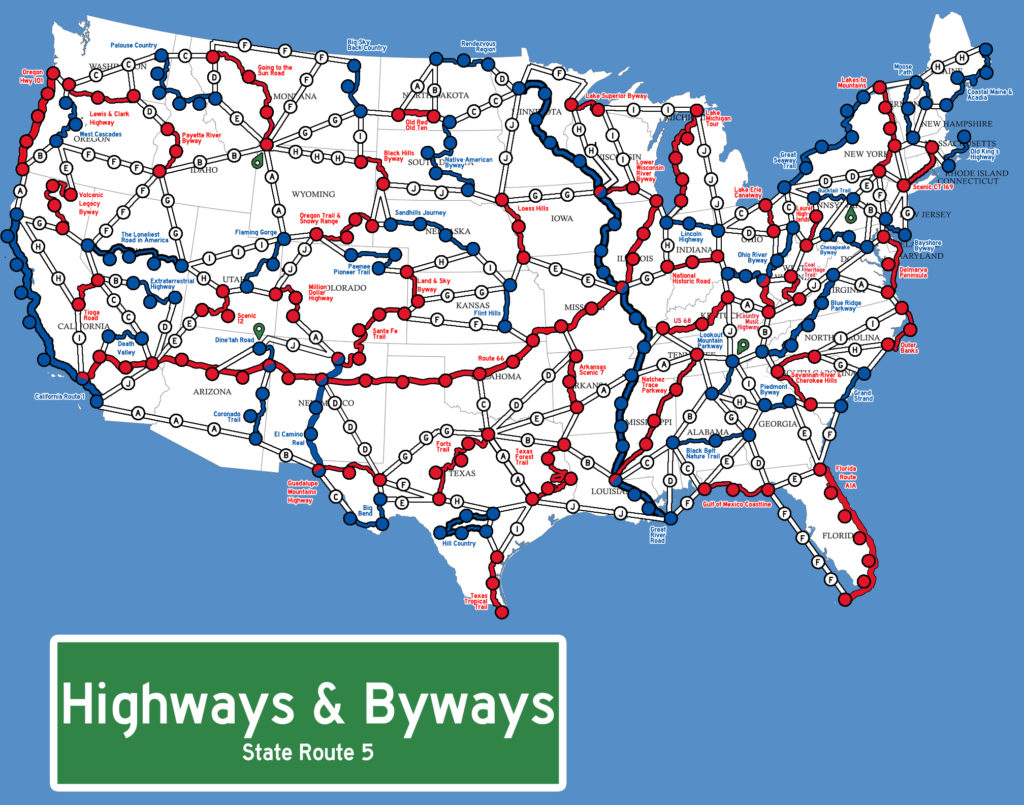Dev Diary posts are made to teach game development through specific examples from my latest project: Highways & Byways.
Just here for Highways & Byways updates? Click here – it will take you right to the updates at the bottom of the page.
The mark of a great game developer is to make great complexity and interaction come out of simple elements. Ironically, though, ensuring simplicity can be a terribly complicated task. My ongoing development of Highways & Byways has got me thinking about the way that we, as game developers, communicate with gamers. I’ve come up with a theory which I call the Five Levels of Communication through Game Development.

Looking for more resources to help you on your board game design journey?
Here you go: no email required!
Like this writing style?
Check out my latest blog on marketing here.
Games tell stories – whether they mean to or not. Chess tells a story. Pandemic tells a story. These stories are told, on purpose or on accident, through five different levels of communication.
This is why when I create games, I aim to evoke a certain feeling. In the case of Highways & Byways, I want you to feel a sense of wanderlust, as if you’re a young person taking an adventurous road trip in a lousy car. There are five ways game developers can communicate the feeling they’re trying to convey. I’ll provide an example of how Highways & Byways addresses each.
Core Engine: If you strip out all the mechanics that put obstacles in your players’ path, what’s left? Obviously not a very good or deep game, but there is still the pursuit of an objective. The core engine is the bare minimum set of mechanics you need to have a functioning game.
In the case of Highways & Byways, the core engine is moving around the United States, aiming to travel a certain set of beautiful byways. It’s a game about travel, exploring, and being in motion.
Mechanics: Games are not very good until you have constraints that make it hard for players to achieve the objective. Mechanics should add obstacles – whether that means the game itself is working against you or other players are. Mechanics include things like player elimination and hand management. Sometimes you consciously create them and sometimes they arise out of rules.
In Highways & Byways, construction slows players down by making some highways periodically impassible. That’s a mechanic. Players draft their destination cards in the beginning, trying to cluster them as close as possible (and sometimes making it hard for others to do the same). That’s a mechanic, a form of hand management.
Rules: These regulate the way mechanics are implemented. The line between rule and mechanic is really thin, and people will argue about the precise nature distinction (or even the existence of a distinction). To me, a mechanic is the concept behind the game and the rule is the way that it’s handled to ensure balance.
Players draft destination cards at the beginning of Highways & Byways. To keep the drafting fair, there’s a rule that says “the first person to pick changes every time, going clockwise.” That way, nobody gets first pick all the time. Likewise, sometimes, you’ll draft something that’s really terrible. Everybody will then get a chance to “mulligan” 2 of 16 destinations they really don’t want to go to.
Internal Narrative: The game also speaks to players not just through the core engine, mechanic, and rules – which constitute the gameplay. It also speaks to players through its theme, story, art, components, and even box design. The internal narrative covers everything about the game itself as a complete product minus the gameplay.
Once Highways & Byways is farther along, I’ll be commissioning art, polishing up its theme, trying to find 3-D printed car pieces (if economically feasible), and making a gorgeous box. That’s all part of the internal narrative (which I haven’t even begun to flesh out yet).
External Narrative: Games are more than just what’s in the box. Games are also the marketing used to promote them – the advertising and the footwork of the game developers who made them. Games are also the Kickstarter campaign and the stores they’re kept in. Games are the community that talks about them on forums and plays them at conventions. Games become everything that people claim that they are.
Highways & Byways is a game, but it’s also a series of blog articles, and a Twitter account. One day, it will be a Kickstarter campaign. I’m making this up as I go along and even as I write this very sentence. Everything I do online and everything others say online changes what this game means to you.
Great games communicate valuable gameplay information at the lowest possible level, preferably core engine and mechanics. One well-made mechanic can resolve the need for ten well-made rules.
My approach to Highways & Byways is very distinct from my approach to War Co. In War Co., I made the game as simple as I knew how to at the core engine and mechanic levels. However, it was still a rule-based game by necessity. That’s fine, however, it’s not optimal. With Highways & Byways, I’m aiming to communicate with players through the core engine and mechanics. If you misunderstand the rules a little bit, I want the game to be just as playable as it would be if you understood them perfectly.
So what made me do all this theorizing in the first place?
Last week I relentlessly ragged on my poor attempt to implement “the traffic mechanic.” The idea was that travel is too easy in the game, so you could slow your opponents down by placing traffic delays and road closures near them. This mechanic was poor from a theme standpoint because it implied players were omnipotent traffic gods. Yet it was even worse from a rules standpoint. Think about the amount of “thou shalt nots” the rules would have to spell out to prevent players from boxing others in, immobilizing them. The mechanic was so inelegant that it would have required a ton of rules to make the game balanced.

I’ve replaced the traffic mechanic with the “construction mechanic.” As I did this, I created version 4 of the game (titled “State Route 4” to keep with the theme). Instead of players choosing where traffic is placed, all highways – basically the fast routes – have one of ten letters on them. Every turn, a construction card is drawn. Players cannot pass any highways whose letters match that of the construction card drawn that turn. My brother and I tested this, and it shows promise.
The construction mechanic requires two or three rules to work. The mechanic stands almost alone in communicating what happens in the game. If the big, bright, orange card turns over with a big letter “B” on it, then you can’t pass B roads. Really straightforward, unlike the traffic mechanic that allowed players to place delays (just as long as they meet these 117 criteria first).
People don’t read rule books very thoroughly, so if your game plays intuitively because of good mechanic design, you have an edge in the market. Just like a movie that can be understood with the sound off, a game that can be played with the rules only skimmed is a sign of clear direction.
Key Takeaways for Game Devs
- The mark of a great game developer is to make great complexity and interaction come out of simple elements.
- The Five Levels of Communication through Game Development
- Core Engine: the bare minimum set of mechanics you need to have a functioning game.
- Mechanics: the constraints that make it hard for players to achieve the objective.
- Rules: regulate the way mechanics are implemented. A mechanic is the concept behind the game and the rule is the way that it’s handled to ensure balance.
- Internal Narrative: everything about the game itself as a complete product minus the gameplay.
- External Narrative: the marketing and the community.
- Great games communicate valuable gameplay information at the lowest possible level, preferably core engine and mechanics.
- You want your mechanics to stand almost alone in communicating what’s happening in the game.
- People don’t read rule books very thoroughly, so if your game plays intuitively because of good mechanic design, you have an edge in the market.
Most Important Highways & Byways Updates
Mentioned Above:
- I updated game to version State Route 4.
- This replaced traffic mechanic with construction mechanic.
- Reduced board crowding by combining some roads and removing others.
Not Mentioned Above:
- I play tested State Route 4.
- My brother and I both liked the construction mechanic and agreed it had potential.
- Identified issues.
- I updated the game to version State Route 5.
- I properly marked starting locations on the map.
- I introduced the Car Choice mechanic.
- I introduced the Event Pool mechanic.
- Early testing so far indicates both the Car Choice and Event Pool mechanics have promise.
- The Event Pool mechanic is going to need a lot of refinement – probably over several game versions.





3 thoughts on “Games Speak through Mechanics, Not Rules”